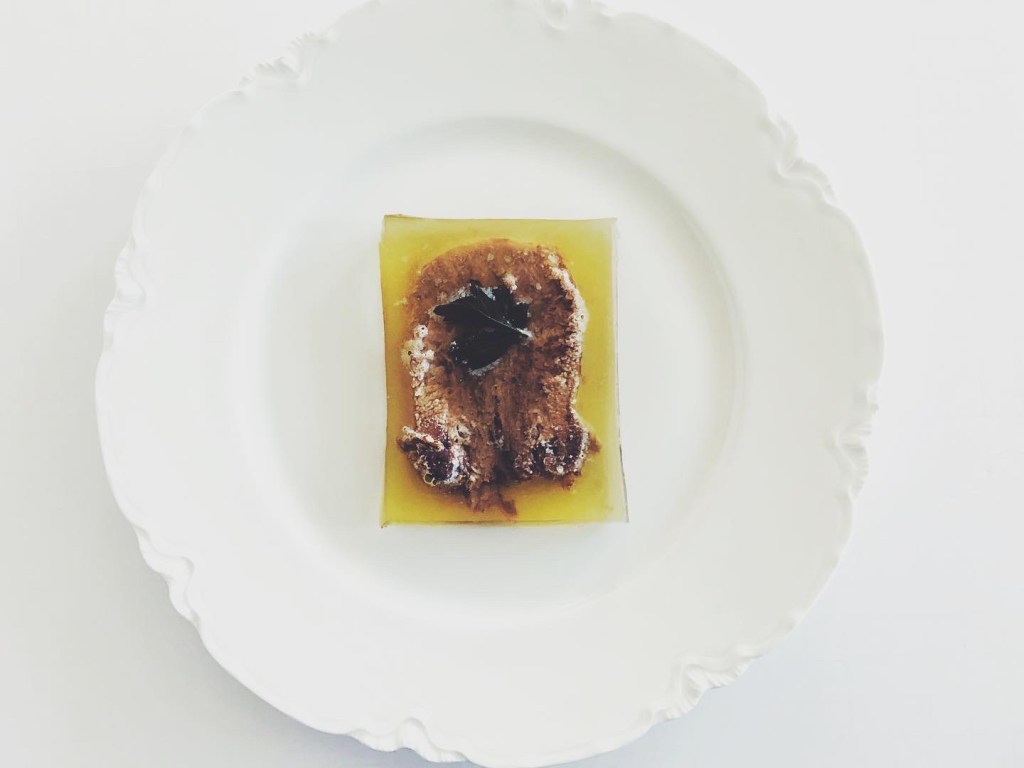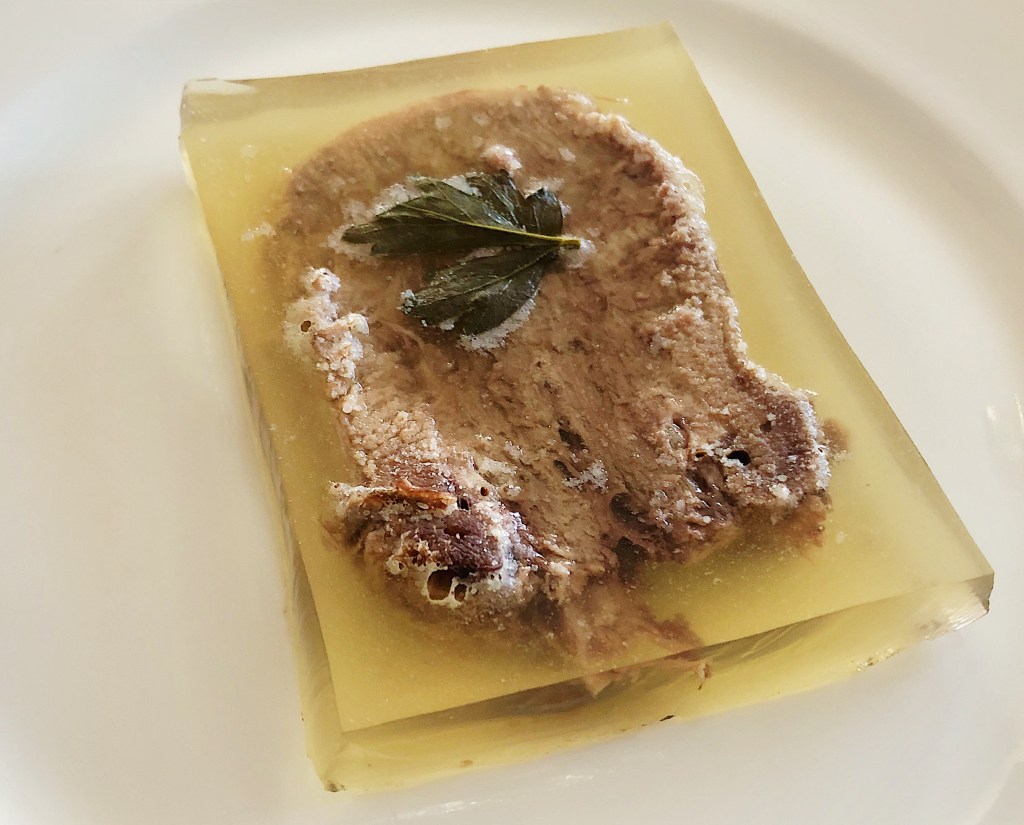For those of you interested in food history, there’s a great magazine called Eaten that explores a number of different culinary topics. Every month or so they do a food challenge and Challenge No. 4 was all about 19th-century Creole food!
Sadly, my project took a day longer than I expected and I missed the deadline to submit this historic beauty. Still, I wanted to give the magazine a shout out because it’s doubtful I would have read this cookbook otherwise.
Creole Cuisine
This recipe comes from an 1885 cookbook called La Cuisine Creole by Lafcadio Hearn. Creole food is a culinary tradition that originated in 18th-century Louisiana in the American South. This culinary style is a unique and complex blend of French, African, Native American, Caribbean and Spanish with hints of other dishes borrowed from Portuguese, Indian and German settlers, among others.
As with all culinary traditions, the way it evolved over time was largely dependent on which ingredients the people had access to. Life on the bayou was significantly different from elsewhere in the New World and Creole cuisine is an obvious reflection of Louisiana’s geographical location and the cultural diversity of the people living there.
Popular Creole foods include jambalaya, gumbo, bisque, grits and grillades, seafood (shrimp, crawfish, salmon), beignets, muffaletta, beans and rice.
Note that Creole and Cajun are two distinct cuisines that are native to Louisiana and they share many similarities. There are subtle cultural differences between the two and some variation in the use of spices and cooking methods, but the main distinction is Creole is the “cosmopolitan” haute cuisine tradition of New Orleans while the Cajun tradition has more rural, swamp country roots and is enjoyed in cities like Lafayette.
The Recipe


When flipping through the book I was immediately drawn to this recipe. It sounds so unappealing to me in every way that I absolutely had to give it a try. Aspic is not nearly as common in the United States as it once was, though in New Orleans you can still find the Creole classic daube glace, which is like a jellied beef stew served on bread or crackers.
Ingredients
- 1 beef tongue
- 2 onions, sliced
- Head of celery, sliced
- 4 cloves
- Salt and pepper to taste
- 2/3 cup brandy
- 1 Tbsp. sugar
- Blade of mace (substitute 1/2 tsp. ground mace or nutmeg)
- Bunch of thyme
- Bunch of parsley, roughly chopped
- 3 packets of plain gelatin
Step ONE: The Tongue
As expected, there are some details missing from this recipe because it was assumed the cook would already know what to do with beef tongue.
Start with a thawed tongue and wash it the best you can, scrubbing it if you have the tool to do so. Put it in a deep pot and cover with salt water. The tongue will eventually float but for now just fill with enough water so it is barely submerged. Bring the water to a boil, turn down the heat and simmer for 2-3 hours.
If you do not know where to get beef tongue, check with your local butcher. I found mine at a Mexican grocery. Lengua is a fairly common Mexican dish.
Peeling the Tongue
Remove the now-tender tongue from the pot (do not dump the water) and mentally prepare yourself to peel it on a clean cutting board or other surface. Let it cool just enough to not burn your fingers, but you’ll want to do this while it is still very warm.
Using a knife, cut a slit in the tip of the tongue and peel off the top layer. You’ll immediately see the meat underneath and it should actually peel very easily. Peel all the way up like a banana, using a fork or your fingers.
All of the meat underneath is edible, but you’ll probably want to trim it a bit, especially around the base. Tongue is a very fatty meat anyway, but you can trim away some of the excess fat if you prefer.
Place the tongue back into the pot of water.
Step TWO: The Broth
Then place it in a stew-pan with two onions, a head of celery, four cloves and salt and pepper; cover it with the liquor it was boiled in; add to it a glass of brandy, a tablespoon of sugar, a blade of mace, a bunch of thyme, and a bunch of parsley. Let it simmer gently for two hours.
Add your onions, celery, cloves, sugar, mace, thyme, parsley and brandy. Salt and pepper it to taste. I did not measure out an exact amount of salt and pepper, but I ended up needing to add a lot more later. It might be better to add additional salt in the next step anyway, after the tongue is fully cooked and when you can taste the broth.
Simmer the tongue and broth for two hours.

Step THREE: The Aspic
Take out the tongue, strain the liquor it was boiled in, and add to it a box of Cox’s gelatine which has been soaked in a goblet of cold water. Heat it and pour it over the tongue.
Take out the tongue and set it aside to cool.
Depending on how much broth you need, use one cup per packet of plain powdered gelatine per cup of broth. That’s about 1/4 oz. or 2 1/2 tsp. gelatine per packet. My recipe calls for three packets, but assuming someone other than me actually makes this, you may need more depending on how you plan to serve the tongue.
Strain three cups of the broth and put in a separate pot. Add additional salt if needed (I recommend being generous with the seasoning). Take one cup of strained broth and set it aside to cool. If you’re short on time, put it in a bowl over some ice. Once the cup of broth is cold, sprinkle three packets of plain gelatine over it and let it soak for 1-2 minutes.
Meanwhile, heat the two cups of strained broth then add the soaked gelatine. Heat until the gelatine has completely dissolved but do not let it boil.

Step FOUR: Mold, Set, Serve
Depending on how you want to present your tongue, you can do this next step a number of ways. I honestly don’t know how it would have been served in 1885 and the recipe provides no additional details!
In my mind, it’s most likely this dish would have been served in slices with a piece of tongue encased in aspic. You could just place your entire tongue in a bread pan and fill it up with the aspic. It might make slicing it a bit difficult, but maybe not.
Another possibility is that it was served a bit like “head cheese.” The tongue may have been cut up or even shredded and placed in a pan. The aspic would have been poured over it, sliced and served like cold gelatinous meatloaf. But the fact that this recipe is called Braised Tongue with Aspic and there are no directions to shred or even cut the meat makes me doubt it was served this way.
I wanted to experiment a little with the cooked tongue and I preferred not to put the entire thing in aspic in case it turned out to be really awful. So for practical reasons, I decided to use the Russian dish zalivnoj jazyk / zalivnoe (Jellied Beef Tongue) as my presentation inspiration.
Slice the tongue lengthwise. Line the bottom a cake or other deep dish with slices of tongue and pour the aspic over the top. If you’re feeling fancy add a couple little leaves of parsley as garnish. Put it in the refrigerator to set overnight. Cut the aspic into squares/rectangles and serve.

The Verdict
I’ll be honest, this was a very off-putting dish texture-wise. Aspic is not an easy food to jump into without having some level of an acquired taste for it.
The flavor, however, was pretty good. The tongue on its own was great and tasted a bit like extremely tender and fatty slow-cooked roast. Eaten with the jelly it reminded me a little of what it’s like eating a big chunk of beef fat, but cold.
If you’re feeling adventurous and want to try something very unique and possibly a little frightening depending on what you’re accustomed to eating, consider this 135 year-old Creole dish. It’s surprisingly less technically challenging than you might expect, but it takes about 8 hours total to make.
Although it’s not my personal favorite dish to eat, it is probably the most memorable and entertaining project I’ve taken on in a while!
Aspic and tongue – not a fave combo of mine! What next… tripe and fennel 😉
LikeLiked by 2 people
Tripe and fennel?? Let me see what I can do… 😆
LikeLiked by 4 people
I love tripe! Try Dominican Mondogo. Its so good!
I love your blog! I have been waiting for the latest post 😆 they are so interesting. History and food is a win win! Thanks for sharing food history. I love it! ❤️
LikeLike
Mondongo sounds very intriguing! I’m going to look into it and see if I can find an older recipe.
Thank you so much! I’m so glad you’re enjoying my blog! I love history and I love to eat so putting the two together is just magical.
LikeLiked by 1 person
It is magical! I look forward to reading your amazing blogs!! ❤️
LikeLike
Aspic has always fascinated me but I’ve been too chicken to taste it. In culinary school they had a small week or two on the history of cooking and talked about how pre-new world the tables of royalty had many many dishes covered in aspic as standard. They used the 2000 film “Vatel” to give us an idea of what kitchen life was like circa Louis XIV. French cuisine was funny to learn about as well. Apparently, it’s Italian cuisine with French ingredients and I imagine Creole is the same with readily available New World ingredients.
LikeLiked by 2 people
This is very interesting, I’ll have to look up this film! I will taste just about anything if it’s for a good cause. lol
I made a 1940’s tomato aspic not too long ago and it wasn’t terrible but it definitely needs to be eaten on a sandwich or something.
LikeLike
I have limited interest in eating beef tongue and absolute zero interest in preparing it seeing the need to “mentally prepare” to peel it! That said I LOVED this post!
LikeLiked by 3 people
Thank you! I made it (and ate it) so you don’t have to. 🙂
LikeLiked by 2 people
Did you use cloves, as in, the spice? If so, could you taste clove in the finished product? When reading the original I assumed the writer meant cloves of garlic.
LikeLike
Yes, cloves the spice. Whole cloves are used this way in a lot of cuisines, especially Indian. When used to flavor a broth they’re always strained out. With only 4 cloves the flavor is so subtle it’s more of an undertone than a spice you can actually taste.
LikeLiked by 1 person
I have had cow tongue burritos and I like those! Thanks for being brave enough to post this! https://www.wisdomforpennies.com
LikeLiked by 1 person
You’re halfway there, now all you need is some aspic!
LikeLike
Thanks.
LikeLike
Ok this sounds absolutely revolting to cook haha especially the peeling of the tongue, how did you do it? eww. You are a lady dedicated to her craft!
LikeLiked by 1 person
I am indeed dedicated. The entire process was both repulsive and fascinating. I would never make this again. Yay history!
LikeLiked by 1 person